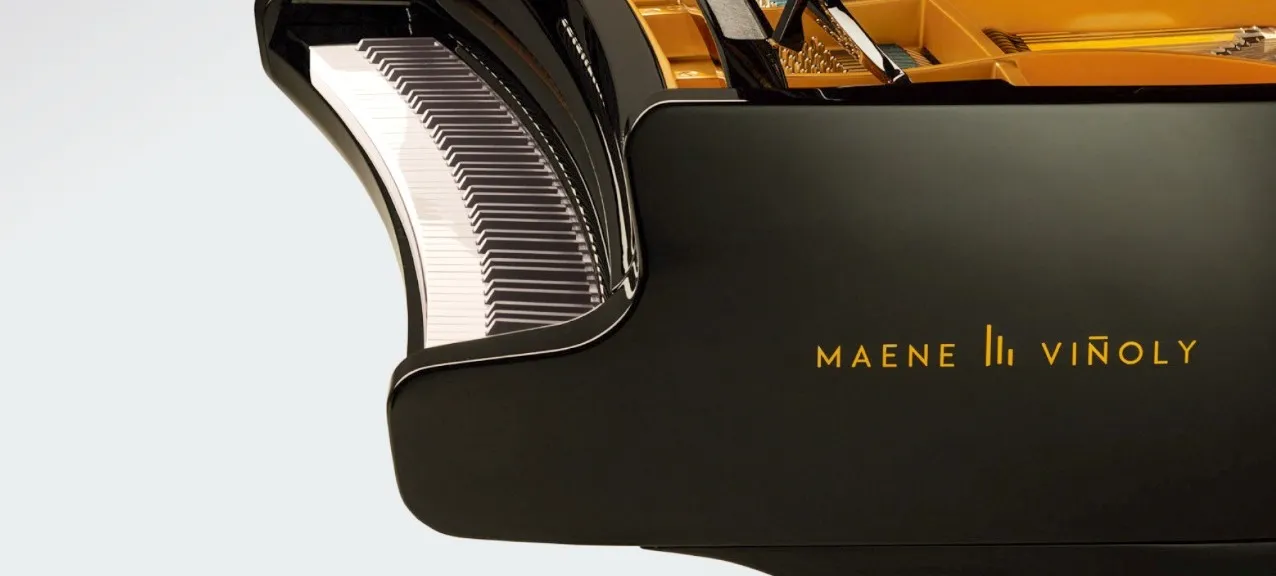Chris Maene about the Maene-Viñoly Concert Grand
Piano builder Chris Maene was interviewed by Rachel Katz for American radio station WWFM's program A Tempo. You can read everything you want to know about innovation in piano land and about the Maene-Viñoly Concert Grand in this interview!

Chris Maene and interviewer Rachel Katz about innovation in piano manufacturing
By way of some brief background and history, have there been major changes in piano design over the past two centuries to better match a pianist's movements?
CM : The curved keyboard is not a new idea. Over the last 2 centuries the key compass has grown from 5 octaves to 71/4 even 8 octaves (Bösendorfer Imperial)
Parallel to the bigger key compass in the second half of the 19th century the first experiments with curved keyboards emerged in different places in Europe
But they had all one thing in common : the action and the hammers remained in the same position as with a normal straight keyboard, only the outer keys were lengthened to make a curve.
Rafael’s idea was that when the keyboard would be re-invented today it would automatically been shaped in a curve
What made this a project that you wanted to work on?
CM : One day back in 2017 Rafael sent me a mail with some sketches of a concert grand with a curved keyboard. He came to me through Maestro Daniel Barenboim, for whom I had made already 2 groundbreaking modern straight strung concert grands.
So far the pianos with curved keyboards I knew where ordinary instruments with a changed keyboard shape. Rafael wanted me to start all over and conceive an instrument following the curved shape of the keyboard, inversing the traditional way of piano building.
It was a honor and challenge for me to cooperate with such an important architect especially since during most of my career I made replicas of historical instruments. Making replicas implies applying concepts, materials and techniques, used by the builders of that time, so there is no room for creativity and personal initiatives.
Building the Maene-Viñoly Concert Grand enabled me to combine all my know-how and experience in one instrument.
What were some of the particular challenges in adapting the traditional piano design to accommodate these changes?
CM : First of all the action is newly conceived from the curve of the keyboard, meaning that the full action has been built in the same curved shape. By putting the strings perpendicularly on the action they come in a fan-like shape. The strings are thus more spread on the bigger soundboard. The case follows though more the natural shaping of the strings and bridges. For the dampers, now in fan shape, we had to invent a new system.
In what ways does the design affect the piano's sound?
CM : It was Rafael’s wish to put the sound quality and the playing comfort upfront. The shape of the piano was always subsidiary to the sound.
We can hear now that the bigger soundboard, the organic shape of the rim and the straight strung concept offer an exquisite, transparent sound with a unique dynamic range.
Is this a design you expect to offer to others in the future?
CM : The Maene-Viñoly Concert Grand is the top of the pyramid. Lots of professional pianists have now tried the curved keyboard and advised us to apply it on all our creations, including the entire straight strung model range. And we are indeed now working on changing the design of our regular straight strung pianos so that we can offer the advantages of the Viñoly design and its ergonomically curved keyboard on every model.
What was it like hearing the piano the first time in performance?
CM : The first public performance was at the Verbier Festival in Switzerland last July, with Kirill Gerstein playing a fantastic recital with sonatas by Stravinsky, Schubert and Liszt.
It was very satisfying to finally hear the result and listen to such a great pianist enjoying all the assets of the instrument.
After so many years of intense work it felt like a big responsibility to give the instrument out of hands but into the hands of a master pianist, in order to convince the audience. And he truly did so!

